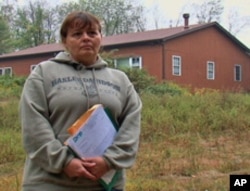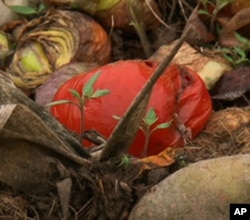At the top of a hill tucked into a rural farming community of Pennsylvania is an abandoned red wooden barn-like house. John Reed was fixing it up, but never moved in. His mother Barbara checks on the property regularly and says John's dream home became a nightmare after his well-water showed high traces of arsenic two years ago. "We no longer drink the water. And he has quit working on his place, and he's now living with us."
Too close for comfort
John Reed's property is 900 meters upwind from a 526-hectare industrial waste pond called Little Blue Run. FirstEnergy Corporation pumps three million tons of scrubber waste - including coal ash - from the local power plant into Little Blue each year. It has done so since 1975.
Reed believes her son has reason to worry because "arsenic is poison." The toxins in coal ash have been linked to cancer, organ failure and other serious health problems.
John Reed is still paying his mortgage, but he doesn't plan to move into his home anytime soon. FirstEnergy has been buying up properties nearby including a nursing home, which looks directly over the toxic pond. It now sits vacant with a padlock on the front door.
'In Harm's Way'
Lisa Marcucci, an outreach worker in Pennsylvania for the Environmental Integrity Project, contributed to a new report on the nation's contaminated coal ash sites called "In Harms Way."
She says Little Blue Run was singled out as one of the worst among 39 sites in 22 states. Environmental advocates from Environmental Integrity Project, the Sierra Club and Earth Justice document each site with records from public files. In the case of Little Blue, According to Marcucci, the company's own records show that - in 2007 and again this year - Little Blue had 10 monitoring wells that spiked pretty high levels for arsenic.
"It seems to me that it should be a very clear signal that there are problems at that site," Marcucci says.
FirstEnergy came to test John Reed's well and then re-tested it. According to company spokesman Mark Durbin, the second tests "showed barely a trace of arsenic." Pennsylvania State Department of Environmental Protection reported similar findings.
Lisa Marcucci says Reed deserves to know more. If FirstEnergy and the Pennsylvania State Department of Environmental Protection are using different documents than those in public file rooms, "They need to explain what set of data are they using, what scientists are they consulting and how are they coming to a determination that there's not a problem," she says. "To just say to people, 'don't worry about it, we're minding the store' isn't good enough. In every case the state and the utility company seem to dismiss the concerns as 'Oh, yes! We're monitoring that. We're on top of it,' but there's never anything seemingly being done beyond the 'We're monitoring' stage."
No federal controls
What concerns Lisa Marcucci and co-worker Lisa Widawsky, an attorney with Environmental Integrity Project, is that there are no federal controls over coal ash, the waste from 600 coal-fired power plants across the country.
"Twenty states have no coal ash regulation at all and that's just of the states that we've looked into so far," says Widawsky. "Among the ones that do have regulations, they're really a patchwork. Some states require ground water monitoring. Some states require some form of corrective action. No state has the whole package."
The U.S. Environmental Protection Agency has proposed two regulatory options. One would label coal ash a hazardous waste, subject to strict federal rules. The other would put coal ash under the same EPA category as household trash and allow states to govern compliance.
In his testimony at an EPA hearing in Crystal City, Virginia, near Washington, DC, Thomas Adams, Executive Director of the American Coal Ash Association told the panel of regulators that calling coal ash hazardous would do more than good to the $9 billion coal-ash industry. "In an effort to create disposal regulations EPA has created a serious potential threat to one of the most successful recycling stories of this generation."
'Hazardous' label
Coal industry lobbyist Jim Roewer is executive director of the Utility Solid Waste Activities Group. He adds that coal ash has been safely mixed into concrete, wall board, road paving, vinyl tiles and dozens of other products for decades. He says relabeling it "hazardous" would kill efforts to recycle it responsibly. "Imagine, if you had the option to buy a product that has fly ash in it or something that doesn't contain fly ash in it, you'd likely not buy the material containing fly ash." Roewer says many state regulatory agencies have laws on the books that say, "If a material is a hazardous waste it can't be beneficially used."
Roewer says companies that sell recycled coal ash products are already feeling the pinch. "We've seen funding dry up for projects, recycling efforts. We've seen people refuse fly ash in concrete because of the potential that that it is going to be regulated as a hazardous waste by EPA."
Lisa Widawsky with the Environmental Integrity Project doesn't buy that argument. She says safely recycled coal ash would not be regulated by the new rule. "No regulation at all will apply to beneficial reuses. Therefore, approved beneficial re-uses, which could include putting this stuff in roads or concrete, there would be no regulation at all. So that really wouldn't cost the states anything. They would be able to continue and they could continue business as usual as long as the reuses that they are engaging in are safe."
Lisa Widawsky says she not waging an attack against coal, and its beneficial reuses, but instead fighting for federally enforceable safeguards - disposal permits, water monitoring, pond liners, and transport controls - to protect people and the environment."
Stricter regulation
Retirees Debby and Curt Havens support the stricter federal rule.
They live downwind from Little Blue Run in Pennsylvania and say it's not unusual to see powdery white coal ash on their grass and flowers. Curt even dug up his vegetable garden this summer rather than reap the harvest, fearing contamination. The couple has begun to speak out on the issue. They've joined a citizens' group and attend public meetings aimed at holding utility companies, state agencies and elected officials accountable.
Lisa Marcucci with the Public Integrity Project believes their story can make a difference. "We want people to know that these are real humans with real lives, real families who are on the front line of this national crisis. I'm hoping that starts to at least open up a more fruitful dialogue about why we need federal rules."
After a period of public comment that ends in November, EPA is expected to release its final ruling.



















